| Cowboy Heros
Tom Mix from Wikipedia
| Thomas Edwin "Tom" Mix (born Thomas Hezikiah Mix; January
6, 1880 – October 12, 1940) was an American film actor and the star of
many early Western movies. Between 1909 and 1935, Mix appeared in 291 films,
all but nine of which were silent movies. He was Hollywood's first Western
megastar and is noted as having helped define the genre for all cowboy
actors who followed.
Early years
Thomas Hezikiah Mix was born January 6, 1880 in Mix Run,
Pennsylvania, about 40 miles (60 km) north of State College, Pennsylvania,
to Edwin and Elizabeth Mix. He grew up in nearby Dubois, Pennsylvania,
where his father, a stable master for a wealthy lumber merchant, taught
him to ride and love horses. He spent time working on a local farm owned
by John Dubois, a lumber businessman. He had dreams of being in the circus
and was rumored to have been caught by his parents practicing knife-throwing
tricks against a wall, using his sister as an assistant.
In April 1898, during the Spanish-American War, he enlisted
in the Army under the name Thomas E. (Edwin) Mix. His unit never went overseas,
and Mix later failed to return for duty after an extended furlough when
he married Grace I. Allin on July 18, 1902. Mix was listed as AWOL on November
4, 1902, but was never court-martialed nor apparently even discharged.
His marriage to Allin was annulled after one year. In 1905, Mix married
Kitty Jewel Perinne, but this marriage also ended within a year. He next
married Olive Stokes on January 10, 1909, in Medora, North Dakota.
In 1905, Mix rode in Theodore Roosevelt's inaugural parade
led by Seth Bullock with a group of 50 horsemen, which included several
former Rough Riders. Years later, Hollywood publicists would muddle this
event to imply that Mix had been a Rough Rider himself. |
.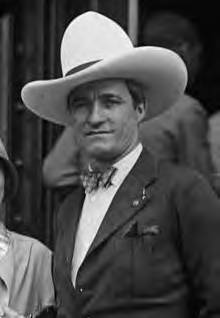
Tom Mix, 1925 |
After working a variety of odd jobs in the Oklahoma Territory,
Mix found employment at the Miller Brothers 101 Ranch, one of the largest
ranching businesses in the United States, covering 101,000 acres (409 km²),
hence its name. He stood out as a skilled horseman and expert shot, winning
national riding and roping contests at Prescott, Arizona in 1909, and Canon
City, Colorado in 1910.
Film career
| Selig Polyscope
Tom Mix began his film career as a supporting cast member
with the Selig Polyscope Company. His first appearance was in a short film
titled The Cowboy Millionaire, released on October 21, 1909. In 1910 he
appeared as himself in a short documentary film titled Ranch Life in the
Great Southwest in which he displayed his skills as a cattle wrangler.
Shot at the Selig studio in the Edendale district of Los Angeles (now known
as Echo Park), the film was a success and Mix became an early motion picture
star.
On July 13, 1912, Olive gave birth to their daughter Ruth.
Mix performed in more than 100 films for Selig, many of which were filmed
in Las Vegas, New Mexico. While with Selig he co-starred in several films
with Victoria Forde, and they fell in love. He divorced Olive Stokes in
1917. By then, Selig Polyscope had encountered severe financial difficulties,
and Tom Mix and Victoria Forde both subsequently signed with Fox Film Corporation,
which had leased the Edendale studio. Mix and Forde married in 1918 and
they had a daughter, Thomasina Mix (Tommie), in 1922. |
.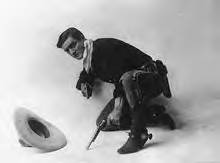
Tom Mix in Mr. Logan, U.S.A., 1919 |
Mixville
| Tom Mix went on to make more than 160 cowboy films throughout
the 1920s. These featured action oriented scripts which contrasted with
the documentary style of his work with Selig. Heroes and villains were
sharply defined and a clean-cut cowboy always "saved the day." Millions
of American children grew up watching his films on Saturday afternoons.
His intelligent and handsome horse Tony also became a celebrity. Mix did
his own stunts and was frequently injured.
Mix's salary at Fox reached $7,500 a week. His performances
weren't noted for their realism but for screen-friendly action stunts and
horseback riding, attention-grabbing cowboy costumes and showmanship. At
the Edendale lot Mix built a 12-acre (49,000 m2) shooting set called Mixville.
Loaded with western props and furnishings, it has been described as a "complete
frontier town, with a dusty street, hitching rails, a saloon, jail, bank,
doctor's office, surveyor's office, and the simple frame houses typical
of the early Western era." Near the back of the lot an Indian village of
lodges was ringed by miniature plaster mountains which on screen were said
to be "ferociously convincing." The set also included a simulated desert,
large corral and a ranch house with no roof, to facilitate interior shots.
During 1929, Mix's last year in silent pictures, he worked
for Film Booking Office of America (FBO), a small movie studio run by Joseph
P. Kennedy Sr. and soon to be merged into Kennedy's RKO Radio Pictures.
Mix was 49 and by most accounts he was ready to retire from the movies.
That same year, Mix was a pallbearer at the funeral of Wyatt Earp (during
which he reportedly wept).
1930s |
.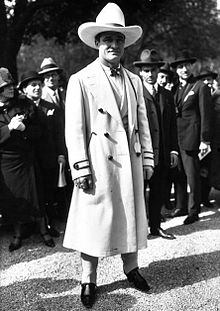
Tom Mix, 1925 |
Mix appeared with the Sells-Floto Circus in 1929, 1930
and 1931 at a reported weekly salary of $20,000. He and Forde were divorced
in 1931. Meanwhile, the Great Depression (along with the actor's free-spending
ways and many wives) had reportedly wiped out most of his savings. In 1932,
he married his fifth wife, Mabel Hubbell Ward. Universal Pictures approached
him that year with an offer to do talkies which included script and cast
approval. He did nine pictures for Universal, but because of injuries he
received
while filming, he was reluctant to continue with any more. Mix then appeared
with the Sam B. Dill circus, which he reportedly bought two years later
(1935).
Mix's last screen appearance was a 15-episode sound Mascot
Pictures serial, The Miracle Rider (1935), receiving $40,000 for four weeks
of filming. Also that year, Texas governor James Allred named Mix an honorary
Texas Ranger. Mix went back to circus performing, this time with his eldest
daughter Ruth, who had appeared in some of his films. In 1938, Mix went
to Europe on a promotional trip, while his daughter Ruth stayed behind
to manage his circus, which soon failed. He later excluded her from his
will. He had reportedly made over $6,000,000 (approaching $400 million
in early 21st century, inflation-adjusted values) during his 26-year film
career.
Radio
In 1933, Ralston-Purina obtained his permission to produce
a Tom Mix radio series called Tom Mix Ralston Straight Shooters which,
but for one year during World War II, was popular throughout most of the
1930s through the early 1950s. Mix never appeared on these broadcasts,
and was instead played by radio actors: Artells Dickson (early 1930s),
Jack Holden (from 1937), Russell Thorsen (early 1940s) and Joe "Curley"
Bradley (from 1944). Others in the supporting cast included George Gobel,
Harold Peary and Willard Waterman.
The Ralston company offered ads during the Tom Mix radio
program for listeners to send in for a series of 12 special Ralston-Tom
Mix Comic books available only by writing the Ralston Company by mail.
Death
| On the afternoon of October 12, 1940, Mix was driving
his 1937 Cord 812 Phaeton near Florence, Arizona, (between Tucson and Phoenix)
on Arizona State Route 79. Mix had been visiting Pima County Sheriff Ed
Nichols in Tucson and had visited the Oracle Junction Inn, a popular
gambling and drinking establishment, where he had called his agent. Heading
toward Phoenix, he came upon construction barriers at a bridge washed away
by a flash flood. He was unable to stop in time. The car swerved twice
then rolled into a gully, pinning his body underneath. He had placed a
large aluminum suitcase containing a large sum of money, traveler's checks
and jewels on the package shelf behind him. It flew forward and struck
Mix's head, shattering his skull and breaking his neck. The 60-year-old
actor was killed almost instantly. Eyewitnesses said Mix had been traveling
at 80 mph. A small stone memorial marks the site of his death on State
Route 79, and the nearby gully is named "Tom Mix Wash". The plaque on the
marker bears the inscription: "In memory of Tom Mix whose spirit left his
body on this spot and whose characterization and portrayals in life served
to better fix memories of the old West in the minds of living men."
Following a funeral at the Little Church of the Flowers,
Tom Mix was interred in the Forest Lawn Memorial Park Cemetery in Glendale,
California. He was 60 years old.
Legacy
Tom Mix was "the King of Cowboys" when Ronald Reagan and
John Wayne were youngsters and the influence of his screen persona can
be seen in their approach to portraying cowboys. When an injury caused
football player John Wayne to drop out of USC, Tom Mix helped him get a
job moving props in the back lot of Fox Studios.
Tom Mix made 291 movies throughout his career. As of 2007,
only about 10% of these were reportedly available for viewing, although
it was unclear how many of these films are now considered lost films.
For his contribution to the motion picture industry, Tom
Mix has a star on the Hollywood Walk of Fame at 1708 Vine Street. His cowboy
boot prints, palm prints and his famous horse Tony's hoof prints are at
Grauman's Chinese Theatre at 6925 Hollywood Boulevard. In 1958 he was inducted
posthumously into the Western Performers Hall of Fame at the National Cowboy
& Western Heritage Museum in Oklahoma City, Oklahoma. In 1959 a 'Monument
To The Stars' was erected on Beverly Dr. (where it intersects with Olympic
Blvd. and becomes Beverwil) in Beverly Hills. The memorial consists of
a bronze-green spiral of sprocketed "camera film" above a multi-sided tower,
embossed with full-length likenesses of early stars who appeared in famous
silent movies. Those memorialized include Douglas Fairbanks, Mary Pickford,
Will Rogers, Conrad Nagel, Rudolph Valentino, Fred Niblo, Tom Mix, and
Harold Lloyd. There is a Tom Mix museum in Dewey, Oklahoma and another
in Mix Run, Pennsylvania. Between 1980 and 2004, 21 Tom Mix festivals were
held during the month of September, most of them in DuBois, Pennsylvania. |
.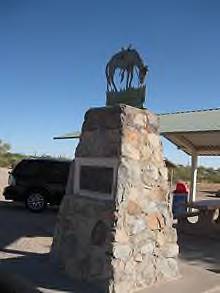
Tom Mix memorial near Florence,
Arizona, the site of his death
.
.
.
.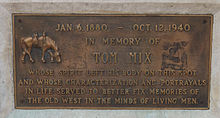
Tom Mix memorial plaque |
Cultural references
By the 21st century, most people were more familiar with
Tom Mix's name through the many cultural references which have echoed long
after his death, rather than from having seen his films. Cereal boxtop
premiums (radio premiums) from the 1940s relating to Mix are still traded
by collectors. Mix was referred to in Conny Froboess' 1951 song "Pack'
die Badehose ein" and in a 1953 Dinah Washington song, "TV Is the Thing
This Year" for EmArcy Records (signifying a change in technology from radio
to television).
By the 21st century, most people were more familiar with
Tom Mix's name through the many cultural references which have echoed long
after his death, rather than from having seen his films. Cereal boxtop
premiums (radio premiums) from the 1940s relating to Mix are still traded
by collectors. Mix was referred to in Conny Froboess' 1951 song "Pack'
die Badehose ein" and in a 1953 Dinah Washington song, "TV Is the Thing
This Year" for EmArcy Records (signifying a change in technology from radio
to television).
In the JD Salinger short story "The
Laughing Man", the Chief is described as having
"the most photogenic features of Buck
Jones, Ken Maynard, and Tom Mix."
In 1967, Mix was featured with many
other 20th century celebrities on the cover of
The Beatles' Sergeant Pepper's Lonely
Hearts Club Band.
In Woody Allen's 1983 film Zelig, archival
footage is shown of Mix attending a party at
Hearst Castle near San Simeon, California.
|
.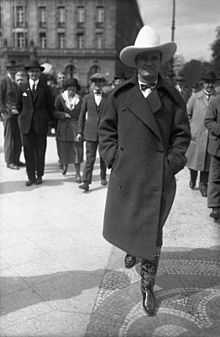
Tom Mix, 1925 |
Bruce Willis played Tom Mix in the 1988
Blake Edwards film Sunset, with James Garner as Wyatt Earp. The film
was very loosely based
on the fact that Earp and Mix knew
each other when Earp was serving as a consultant during the silent
film era.
In The Beverly Hillbillies, Jed Clampett's
reason for going to Beverly Hills was to live in the
same place as Tom Mix.
Daryl Ponicsan's novel Tom Mix Died
for Your Sins (1975) evokes Mix's life and personality. Clifford Irving
offered a
pseudo-autobiographical version of
Mix's early adulthood, drawing him as a brash young gringo who befriends
and then joins up with
the Mexican revolutionary Pancho Villa
in the novel Tom Mix and Pancho Villa (1982).
In the 2008 movie Changeling, starring
Angelina Jolie, the mysterious little boy claiming to be Walter Collins
finally confesses to the
police that the reason he ran away
to Los Angeles was in hopes of meeting Tom Mix and his horse Tony.
In the children's novel "Letters From Rifka"
by "Karen Hesse", the protagonist Rifka Nebrot mentions learning the English
language by
reading comic books about a cowboy named
Tom Mix who shoots at bad guys.
James Horwitz's book They Went Thataway (1975)
ends with Horwitz visiting Tom Mix Wash (where Mix died) and leaving his
childhood
cowboy boots at the foot of the monument.
A resurrected Tom Mix appeared in two of
Philip José Farmer's Riverworld novels, The Dark Design (1977) and
The Magic Labyrinth (1980)
as a traveling companion of Jack London,
along with a short story featured in the anthology Riverworld and Other
Stories (1979).
In the "Mulcahy's War" episode of M*A*S*H
Father Mulcahy used a Tom Mix pocket knife to perform an emergency tracheotomy
(1976).
Philip K. Dick's sci-fi novel The Penultimate
Truth features an underground bunker named 'the Tom Mix'.
In Batman/Houdini: The Devil's Workshop (1993),
Tom Mix is a high profile figure in Gotham society, and takes up Houdini's
offer of a free
punch to the stomach.
In the Star Trek: Deep Space Nine novel The
Laertian Gamble, Miles O'Brien reads a Tom Mix Western.
In an episode of Raw Toonage, Bonkers D.
Bobcat plays a cowboy character named "Trail Mix Bonkers", an obvious homage
to Tom Mix,
as well as a play on both his name and trail
mix.
The menacing cowboy character in David Lynch's
film Mulholland Drive contains oblique references to Mix.
The ghost of Tom Mix haunted a Hollywood
couple in the supernatural thriller The Ghosts of Edendale (2004).
Ralston-Purina briefly revived its Tom Mix
boxtop fan club during the 1980s, and in 2007 had Tom Mix pages on the
company's website.
Tom Mix is mentioned as being a pall bearer
and weeping at the funeral for Wyatt Earp at the beginning of the end credits
for the 1993
George P. Cosmatos film Tombstone.
In the Doctor Who episode "The Gunfighters",
the TARDIS lands at Tombstone, Arizona in 1881, where the Doctor says he
doesn't
understand why they want to dress like Tom
Mix.
The United States Postal Service has commemorated
Tom Mix on a first-class mail postage stamp.
In Salt-Water Moon, by Canadian playwright
David French, Jacob describes watching "The Lucky Horseshoe", calling it
"one of the best
Tom ever made," and tries to seduce Mary
when describing it.
Italian comic series Captain Miki was renamed
by comics calligrapher Ferdi Say??man as "Captain Tom Mix" (Yüzba??
Tommiks) in the
70s, and comics are being published with
this name till today.
In the series Bewitched in the episode "Serena's
Youth Pill", Darin tries to convince young Larry Tate to drink the magic
antidote by
telling him it would help Larry grow up
to be a cowboy like Tom Mix.
In the 2010 Boardwalk Empire episode "The
Emerald City", Nucky Thompson's servant Eddie Kessler offers to frisk someone
who's come
to see him. Nucky chides him: "You're Tom
Mix all of a sudden?"
|
Willaim Hart from Wikipedia
.
| William Surrey Hart (December 6, 1864 – June 23, 1946)
was an American silent film actor, screenwriter, director and producer.
He is remembered for having "imbued all of his characters with honor and
integrity.
Biography
Hart was born in Newburgh, New York; to James Howard Hart
(1829–1902) and Katherine Diédricht Hart (1833–1909). William had
2 brothers and 4 sisters. His father was of Irish ancestry, and his mother
was of German heritage. Hart began his acting career on stage in his 20s
and in film when he was 49, which coincided with the beginning of film's
transition from curiosity to commercial art form. He toured and traveled
extensively while trying to make a name for himself as an actor, and for
a time coached shows at the Asheville Opera House around year 1900. His
family had moved to Asheville but after his youngest sister Lotta died
of typhoid fever they all left together for Brooklyn until William went
back on tour.
A successful Shakespearean actor on Broadway who had worked
with Margaret Mather and other stars, he appeared in the original 1899
stage production of Ben-Hur. |
.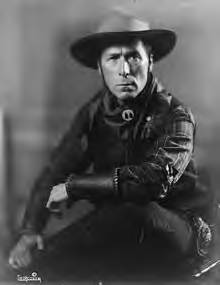 |
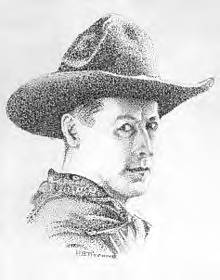
Sketch of William S. Hart in 1929 |
Hart went on to become one of the first great stars of
the motion picture western. Fascinated by the Old West, he acquired Billy
the Kid's "six shooters" and was a friend of legendary lawmen Wyatt Earp
and Bat Masterson. He entered films in 1914 where, after playing supporting
roles in two short films, he achieved stardom as the lead in the feature
The Bargain. Hart was particularly interested in making realistic western
films. His films are noted for their authentic costumes and props, as well
as Hart's extraordinary acting ability, honed on Shakespearean theater
stages in the United States and England.
Beginning in 1915, Hart starred in his own series of two-reel
western short subjects for producer Thomas Ince, which were so popular
that they were supplanted by a series of feature films. Many of Hart's
early films continued to play in theaters, under new titles, for another
decade. In 1915 and 1916 exhibitors voted him the biggest money making
star in the US. In 1917 Hart accepted a lucrative offer from Adolph Zukor
to join Famous Players-Lasky, which merged into Paramount Pictures. In
the films Hart began to ride a brown and white pinto he called Fritz. Fritz
was the forerunner of later famous movie horses known by their own name,
i.e., horses like Tom Mix's Tony, Roy Rogers's Trigger and Clayton Moore's
Silver, etc. Hart was now making feature films exclusively, and films like
Square Deal Sanderson and The Toll Gate were popular with fans. Hart married
young Hollywood actress Winifred Westover. Although their marriage was
short-lived, they had one child, William S. Hart, Jr.(1922–2004). |
By the early 1920s, however, Hart's brand of gritty, rugged
westerns with drab costumes and moralistic themes gradually fell out of
fashion. The public became attracted by a new kind of movie cowboy, epitomized
by Tom Mix, who wore flashier costumes and was faster with the action.
Paramount dropped Hart, who then made one last bid for his kind of western.
He produced Tumbleweeds (1925) with his own money, arranging to release
it independently through United Artists. The film turned out well, with
an epic land-rush sequence, but did only fair business at the box office.
Hart was angered by United Artists' failure to promote his film properly
and sued United Artists. The legal proceedings dragged on for years, and
the courts finally ruled in Hart's favor, in 1940.
.
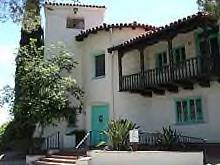 . .
Hart's ranch home,
“La Loma de los Vientos”
in Newhall, California, built between
1924 and 1928 in the Spanish Colonial
Revival architectural style,
is currently a museum |
After Tumbleweeds, Hart retired to his Newhall, California,
ranch home, “La Loma de los Vientos,” which was designed by architect Arthur
R. Kelly. In 1939 he appeared in his only sound film, a spoken prologue
for a reissue of Tumbleweeds. The 75-year-old Hart, filmed on location
at his Newhall ranch, reflects on the Old West and recalls his silent-movie
days fondly. The speech turned out to be William S. Hart's farewell to
the screen, and it's a fitting valedictory. Most prints and video versions
of Tumbleweeds circulating today include Hart's speech. Hart died on June
23, 1946, in Newhall, California at the age of 81. He was buried in Green-Wood
Cemetery in Brooklyn, New York.
Dedications
For his contribution to the motion picture industry, William
S. Hart has a star on the Hollywood Walk of Fame at 6363 Hollywood Blvd.
In 1975, he was inducted into the Western Performers Hall of Fame at the
National Cowboy & Western Heritage Museum in Oklahoma City, Oklahoma.
As part of the Natural History Museum of Los Angeles County,
California, Hart's former home and 260-acre (1.1 km²) ranch in Newhall
is now William S. Hart Park. The William S. Hart High School District as
well as William S. Hart Senior High School, both located in the Santa Clarita
Valley
in the northern part of Los Angeles County, were named
in his honor. |
On November 10, 1962, Hart was honored posthumously in
an episode of the short-lived The Roy Rogers and Dale Evans Show, a western
variety program on ABC.
|
William Boyd from Wikipedia
.
| William Lawrence Boyd (June 5, 1895 – September 12, 1972)
was an American film actor best known for portraying Hopalong Cassidy.
Biography
Boyd was born in Hendrysburg in Belmont County, located
26 miles east of Cambridge, Ohio. He was reared in Tulsa, Oklahoma, the
son of day laborer Charles William Boyd and his wife, the former Lida Wilkens.
Following his father's death, he moved to California and worked as an orange
picker, surveyor, tool dresser and auto salesman.
In Hollywood, he found extra work in Why Change Your Wife?
and other films. During World War I, he enlisted in the army but was exempt
because of a "weak heart." More prominent film roles followed, and he became
famous as a leading man in silent film romances, earning an annual salary
of $100,000. He was the lead actor in Cecil B. DeMille's The Volga Boatman
(1926) and DeMille's extravaganza, The King of Kings, helping Christ carry
the cross as Simon of Cyrene and also in DeMille's Skyscraper. He then
appeared in D.W. Griffith's, Lady of the Pavements (1929).
Radio Pictures ended Boyd's contract in 1931 when his
picture was mistakenly run in a newspaper story about the arrest of another
actor, William "Stage" Boyd, on gambling and liquor charges. Having been
reckless with his money, Boyd was broke and without a job, and for a few
years he was credited in several films as "Bill Boyd" to prevent being
mistaken for his actor namesake. |
.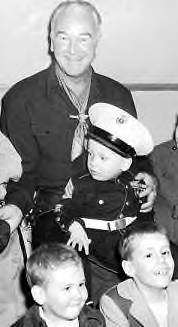
Chicago (circa 1950) |
Hopalong Cassidy
In 1935, he was offered the supporting role of Red Connors
in the movie Hop-Along Cassidy, but asked to be considered for the title
role and won it. The original Hopalong Cassidy character, written by Clarence
E. Mulford for pulp fiction, was changed from a hard-drinking, rough-living
wrangler to its eventual incarnation as a cowboy hero who did not smoke,
drink or swear and who always let the bad guy start the fight. Although
Boyd "never branded a cow or mended a fence, cannot bulldog a steer", and
disliked Western music, he became indelibly associated with the Hopalong
character and, like rival cowboy stars Roy Rogers and Gene Autry, gained
lasting fame in the Western film genre. The Hopalong Cassidy series ended
in 1947 after 66 films, with Boyd producing the last 12.
Anticipating television's rise, Boyd spent $350,000 to
purchase the rights to the Hopalong Cassidy character, books and films.
In 1949, he released the films to television, where they became extremely
popular and began the long-running genre of Westerns on television. Like
Rogers and Autry, Boyd licensed much merchandise, including such products
as Hopalong Cassidy watches, trash cans, cups, dishes, Topps trading cards,
a comic strip, comic books, radio shows and cowboy outfits. The actor identified
with his character, often dressing as a cowboy in public. Although Boyd's
portrayal of Hopalong made him very wealthy, he believed that it was his
duty to help strengthen his "friends" - America's youth. The actor refused
to license his name for products he viewed as unsuitable or dangerous,
and turned down personal appearances at which his "friends" would be charged
admission.
Boyd appeared as Hopalong Cassidy on the cover of numerous
national magazines, including the August 29, 1950 issue of Look and the
November 27, 1950 issue of Time.
Boyd had a cameo as himself in Cecil B. DeMille's 1952
circus epic, The Greatest Show on Earth. DeMille reportedly asked Boyd
to take the role of Moses in his remake, The Ten Commandments, but Boyd
felt his identification with the Cassidy character would make it impossible
for audiences to accept him as Moses.
Personal life
Boyd was married five times, first to Laura Maynard and
then to actresses Ruth Miller, Elinor Fair, Dorothy Sebastian and Grace
Bradley. A son, by third wife Fair, died aged 9 months. Following his retirement
from the screen, Boyd invested both his time and money in real estate and
moved to Palm Desert, California. He refused interviews and photographs
in later years, preferring not to disillusion his millions of fans who
remembered him as their screen idol.
For his contribution to the motion picture industry, he
has a star on the Hollywood Walk of Fame at 1734 Vine Street. In 1995,
he was inducted into the Western Performers Hall of Fame at the National
Cowboy & Western Heritage Museum in Oklahoma City, Oklahoma.
The original American Pie album by Don McLean inner sleeve
featured a free verse poem written by McLean about Boyd along with a picture
of Boyd in full Hopalong regalia. This sleeve was removed within a year
of the album's release. The words to this poem appear on a plaque at the
hospital where Boyd died.
At his death in 1972, he was survived by his fifth wife,
actress Grace Bradley Boyd, who died on September 21, 2010 on her 97th
birthday.
Posthumous
Since 1991, the Friends of Hoppy Fan Club has held the
Hopalong Cassidy Festival in Cambridge, Ohio, near Boyd's birthplace.
|
.
All articles submitted to the "Brimstone
Gazette" are the property of the author, used with their expressed permission.
The Brimstone Pistoleros are not
responsible for any accidents which may occur from use of loading
data, firearms information, or recommendations published on the Brimstone
Pistoleros web site. |
|